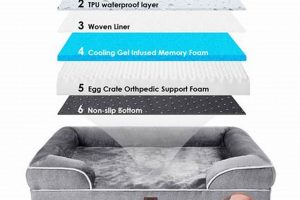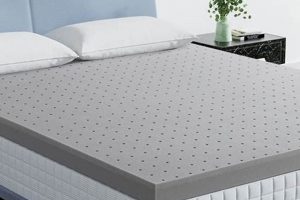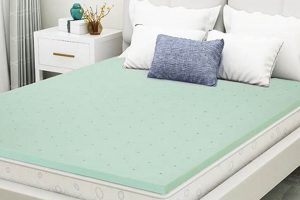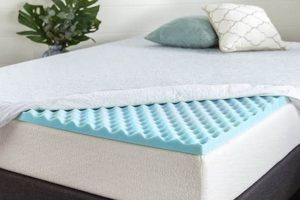Memory foam mattresses, while known for their comfort and support, can sometimes retain body heat, leading to an uncomfortably warm sleep environment. Addressing this issue involves understanding the material’s properties and implementing strategies to improve airflow and reduce heat retention. Examples of such strategies include using breathable bedding materials, employing cooling mattress pads, and optimizing room temperature and ventilation.
Maintaining a cool sleep surface is crucial for achieving restful sleep, particularly for individuals prone to night sweats or living in warmer climates. A cooler sleep environment can contribute to better sleep quality, reduced tossing and turning, and improved overall well-being. Historically, methods for cooling mattresses have evolved from simple techniques like using natural fibers to more advanced technologies involving gel infusions and phase-change materials.
The following sections will detail specific methods for mitigating heat retention in memory foam mattresses. These methods range from simple adjustments to more significant investments in cooling technologies, allowing for a customized approach to achieving a more comfortable sleep experience.
Strategies for Thermal Regulation of Memory Foam Mattresses
Addressing excessive heat retention in memory foam mattresses requires a multifaceted approach, focusing on improving airflow and reducing heat absorption. Implementing the following strategies can contribute to a cooler and more comfortable sleep environment.
Tip 1: Utilize Breathable Bedding: Opt for sheets and pillowcases made from natural fibers such as cotton, linen, or bamboo. These materials promote airflow and wick away moisture, preventing heat buildup. Avoid synthetic fabrics like polyester, which tend to trap heat.
Tip 2: Employ a Cooling Mattress Pad: Consider using a mattress pad specifically designed for cooling. These pads often incorporate technologies such as gel infusions or phase-change materials that absorb and dissipate heat. Ensure the pad itself is constructed from a breathable fabric.
Tip 3: Optimize Room Temperature and Ventilation: Maintain a consistent room temperature between 60-67 degrees Fahrenheit (15-19 degrees Celsius). Utilize fans or air conditioning to circulate air and remove stagnant heat. Open windows when possible to allow for natural ventilation.
Tip 4: Consider a Gel-Infused Memory Foam Mattress: If purchasing a new mattress is an option, explore gel-infused memory foam models. The gel particles help to draw heat away from the body, providing a cooler sleeping surface.
Tip 5: Use a Slatted Bed Frame: A slatted bed frame allows for better airflow underneath the mattress compared to a solid platform. This can help to dissipate heat that accumulates within the mattress.
Tip 6: Rotate the Mattress Regularly: Rotating the mattress periodically can help to distribute wear and prevent the formation of heat pockets in specific areas.
Tip 7: Minimize Body Contact: While not always practical, minimizing direct skin contact with the mattress can reduce heat transfer. Consider wearing lightweight, breathable sleepwear.
Implementing these thermal regulation strategies can significantly improve sleep comfort by mitigating the heat retention associated with memory foam mattresses, leading to a more restful and restorative sleep experience.
The subsequent sections will delve into the scientific principles behind these cooling methods, providing a deeper understanding of their effectiveness.
1. Breathable Bedding
The effectiveness of managing heat retention in memory foam mattresses is significantly influenced by the breathability of the bedding materials used. Memory foam, by its inherent nature, tends to trap heat due to its dense structure and limited airflow. This characteristic can lead to an uncomfortable sleeping environment, particularly for individuals susceptible to overheating. Utilizing breathable bedding materials, such as cotton, linen, bamboo, or Tencel, directly addresses this issue by facilitating the movement of air and moisture away from the body. This process allows for heat dissipation, thus contributing to a cooler sleep surface. For example, replacing polyester sheets, known for their heat-trapping properties, with linen sheets can demonstrably reduce the temperature of the sleeping surface.
The specific mechanism by which breathable bedding contributes to cooling involves both convection and evaporation. The open weave of natural fibers allows for convective heat transfer, enabling warm air to escape and cooler air to circulate. Simultaneously, these materials possess moisture-wicking properties, drawing perspiration away from the skin. This process promotes evaporative cooling, further reducing body temperature. For instance, individuals experiencing night sweats may find significant relief by switching to bamboo sheets, which excel at moisture absorption and ventilation. Furthermore, the thread count of cotton sheets can impact breathability, with lower thread counts generally offering better airflow.
In summary, the choice of bedding materials is a critical factor in mitigating heat retention in memory foam mattresses. Breathable bedding acts as a primary defense against overheating by promoting airflow and moisture evaporation. While other cooling strategies, such as using cooling mattress pads or adjusting room temperature, can supplement this approach, selecting breathable bedding constitutes a foundational step towards achieving a more comfortable and cooler sleep environment. The efficacy of this approach is grounded in the principles of heat transfer and the inherent properties of natural fibers, making it a practical and effective solution.
2. Cooling mattress pads
The correlation between cooling mattress pads and thermal regulation of memory foam mattresses is direct and significant. Memory foam, appreciated for its conforming properties, also tends to retain heat, creating a potentially uncomfortable sleep environment. Cooling mattress pads serve as an intervention, actively mitigating heat retention and contributing to improved sleep comfort. The inclusion of a cooling mattress pad is a direct response to the question of how to reduce the thermal impact of memory foam.
These pads often incorporate advanced materials and designs to facilitate heat dissipation. Gel-infused memory foam, phase-change materials, and breathable fabrics are common components. Gel infusions draw heat away from the body, while phase-change materials absorb and release heat to maintain a stable temperature. Breathable fabrics promote airflow, preventing heat from becoming trapped between the body and the mattress. An example of the impact: an individual experiencing ni
ght sweats may find considerable relief using a cooling mattress pad featuring phase-change material, as it regulates temperature fluctuations throughout the night. Conversely, a standard mattress pad lacking cooling properties will likely exacerbate the sensation of heat, hindering sleep quality.
In summation, cooling mattress pads represent a tangible solution to the issue of heat retention in memory foam mattresses. Their incorporation of specific materials and designs directly addresses the thermal properties of memory foam, creating a more comfortable sleeping surface. While other factors, such as bedding and room temperature, also contribute to the overall sleep environment, cooling mattress pads provide a targeted approach to temperature regulation. Understanding this connection is crucial for individuals seeking to optimize their sleep quality when using a memory foam mattress.
3. Room temperature
Room temperature exerts a significant influence on the thermal properties of a memory foam mattress. The mattress, being susceptible to heat retention, is directly impacted by the ambient temperature of the surrounding environment. Elevated room temperatures exacerbate the heat-trapping tendency of the foam, resulting in a warmer sleep surface. Conversely, lower room temperatures can mitigate this effect, contributing to a cooler sleeping experience. The effectiveness of other cooling strategies, such as breathable bedding or cooling mattress pads, is also dependent on the prevailing room temperature; they are more effective in cooler environments.
The recommended room temperature for optimal sleep is typically between 60-67 degrees Fahrenheit (15-19 degrees Celsius). Maintaining a temperature within this range facilitates the dissipation of heat from the mattress, allowing the body to regulate its temperature more effectively. For instance, an individual employing a cooling gel mattress pad in a room maintained at 75 degrees Fahrenheit will likely experience limited benefit, as the ambient heat overpowers the cooling properties of the pad. However, the same pad used in a room cooled to 65 degrees Fahrenheit will provide a more noticeable and beneficial effect. The use of air conditioning or fans is often necessary to achieve and maintain this temperature range, particularly during warmer months. Furthermore, factors such as insulation and window placement can influence room temperature stability, requiring adjustments to cooling strategies.
In summary, room temperature is a critical variable in controlling the thermal environment surrounding a memory foam mattress. While other cooling methods can offer localized relief, their efficacy is intrinsically linked to the ambient temperature. Failing to address room temperature can render other cooling efforts ineffective. Therefore, prioritizing temperature management through air conditioning, ventilation, and insulation is a fundamental step in addressing heat retention and promoting a cooler, more comfortable sleep experience when using a memory foam mattress. The challenge lies in achieving a consistent and stable room temperature that complements other cooling measures.
4. Air circulation
Air circulation is a crucial component in managing the thermal properties of memory foam mattresses. The inherent density of memory foam restricts natural airflow, contributing to heat retention and potential discomfort. Adequate air circulation mitigates this issue by facilitating the removal of warm air surrounding the body and the mattress, replacing it with cooler air. Without sufficient air movement, heat becomes trapped, negating the effectiveness of other cooling strategies. For example, a person employing a cooling mattress pad in a poorly ventilated room will likely experience limited relief compared to someone using the same pad in a room with good airflow. The principle is that consistent air movement aids in the convection of heat away from the sleeping surface.
The implementation of air circulation strategies can take various forms. Simple measures such as using fans to circulate air within the room or opening windows to promote natural ventilation can be effective. More advanced solutions include using bed frames with open slat designs, which allow air to flow underneath the mattress, preventing heat from becoming trapped. Some mattresses also incorporate design features, such as channeled foam layers, to promote internal airflow. Moreover, the positioning of furniture within the room can impact air circulation; avoiding obstructions that block airflow to the bed can further enhance cooling efforts. For instance, ensuring that vents are unobstructed and that the bed is not placed directly against a wall promotes more effective air movement.
In summary, air circulation plays a vital role in the overall management of heat associated with memory foam mattresses. It directly counteracts the heat-trapping properties of the foam by facilitating the removal of warm air and the introduction of cooler air. Without adequate air circulation, other cooling methods are significantly diminished in their effectiveness. Therefore, prioritizing air movement through the use of fans, ventilation, and appropriate bed frame designs constitutes a fundamental aspect of achieving a cooler and more comfortable sleep environment with a memory foam mattress.
5. Mattress ventilation
Mattress ventilation is a critical factor in mitigating heat retention associated with memory foam mattresses. The inherent density of memory foam restricts natural airflow, leading to heat buildup and reduced sleep comfort. Addressing this limitation through effective ventilation strategies is paramount in achieving a cooler sleep environment.
- Bed Frame Design and Airflow
The design of the bed frame significantly influences mattress ventilation. Solid platform beds inhibit airflow, trapping heat between the mattress and the platform. In contrast, slatted bed frames or those with open designs facilitate air circulation beneath the mattress, allowing heat to dissipate more effectively. For example, replacing a solid platform with a slatted frame can noticeably reduce heat buildup within the mattress, particularly in warmer climates.
- Mattress Construction and Breathability
Certain mattress designs incorporate features specifically intended to enhance ventilation. These may include channeled foam layers, perforated foam cores, or the integration of breathable materials like open-cell memory foam. These design elements promote airflow within the mattress itself, reducing heat retention and improving overall comfort. Mattresses with these features are often marketed as “cooling” mattresses due to their enhanced ventilation capabilities.
- Environmental Factors and Ventilation Effectiveness
The effectiveness of mattress ventilation is also influenced by environmental factors. Adequate room ventilation, achieved through open windows, fans, or air conditioning, enhances the cooling effect of a well-ventilated mattress. Conversely, a poorly ventilated room can negate the benefits of even the most breathable mattress. For instance, a mattress placed in a small, closed room with limited airflow will like
ly retain more heat than the same mattress in a larger, well-ventilated space. - Maintenance Practices and Long-Term Ventilation
Regular mattress maintenance can help preserve its ventilation capabilities. Rotating or flipping the mattress periodically ensures even wear and prevents compression that can impede airflow. Additionally, vacuuming the mattress can remove dust and debris that may clog ventilation channels or pores. Neglecting these practices can gradually reduce the mattress’s ability to dissipate heat effectively over time.
Effective mattress ventilation strategies, encompassing bed frame design, mattress construction, environmental control, and maintenance practices, collectively contribute to mitigating heat retention in memory foam mattresses. Addressing this aspect is crucial for individuals seeking to optimize sleep comfort and address thermal issues associated with this type of mattress.
6. Gel-infused foam
The integration of gel into memory foam directly addresses the issue of heat retention, a primary concern when considering methods to cool down memory foam mattresses. Gel-infused foam functions as a thermal regulator, mitigating the tendency of traditional memory foam to trap body heat. This is achieved through the gel’s inherent properties, which allow it to absorb and dissipate heat more effectively than the surrounding foam. The presence of the gel creates a pathway for heat to be drawn away from the sleeper, contributing to a cooler sleeping surface. For instance, individuals who find standard memory foam uncomfortably warm often experience improved sleep comfort with gel-infused alternatives. The specific type and concentration of gel used can influence the degree of cooling achieved, ranging from subtle improvements to significantly cooler sleep experiences.
The practical application of gel-infused foam extends beyond simple comfort. For individuals experiencing night sweats or living in warmer climates, the cooling effect can be particularly beneficial in preventing sleep disturbances. Gel-infused mattress toppers, for example, offer a relatively affordable means of modifying an existing mattress to improve its thermal performance. The design and construction of the gel-infused foam also play a role in its effectiveness. Open-cell structures within the foam enhance airflow, further contributing to heat dissipation. The density and distribution of the gel are also critical factors, influencing the overall cooling capacity and durability of the mattress or topper. Some manufacturers combine gel infusions with other cooling technologies, such as phase-change materials, to achieve even greater temperature regulation.
In conclusion, gel-infused foam represents a significant advancement in addressing the heat retention issues associated with memory foam mattresses. Its ability to absorb and dissipate heat makes it a valuable component of cooling strategies. While the effectiveness of gel-infused foam can vary depending on factors such as gel type, concentration, and construction, its role in promoting a cooler sleep environment is well-established. The ongoing development of new gel technologies and foam structures promises further improvements in thermal regulation, offering enhanced comfort and sleep quality for memory foam users. Challenges remain in optimizing the balance between cooling performance, durability, and cost, but the underlying principle of gel infusion as a cooling mechanism remains a cornerstone of modern mattress design.
7. Slatted bedframes
Slatted bedframes play a significant, albeit often overlooked, role in mitigating heat retention in memory foam mattresses. The design of these frames directly influences airflow beneath the mattress, impacting its capacity to dissipate heat and contribute to a cooler sleeping environment. Their open structure contrasts sharply with solid platform beds, which restrict airflow and can exacerbate heat buildup.
- Air Circulation Enhancement
The primary function of a slatted bedframe in cooling a memory foam mattress is to enhance air circulation. The spaces between the slats allow air to flow freely beneath the mattress, preventing the accumulation of trapped heat. This is particularly important for memory foam, which is known for its density and limited breathability. As an example, placing a memory foam mattress on a solid platform bed often results in a noticeable increase in temperature compared to using a slatted frame, especially during warmer months. The enhanced airflow facilitates convection, allowing warm air to rise and be replaced by cooler air.
- Moisture Management
Beyond heat dissipation, slatted bedframes also aid in moisture management. Perspiration and humidity can accumulate within a mattress, creating a damp and uncomfortable sleeping environment. The improved airflow provided by a slatted frame helps to evaporate moisture, reducing the risk of mold and mildew growth and promoting a drier, cooler sleep surface. This is particularly beneficial for individuals who experience night sweats or live in humid climates. Adequate ventilation prevents moisture from becoming trapped and contributing to a cycle of heat retention.
- Material and Construction Considerations
The effectiveness of a slatted bedframe in promoting cooling is also influenced by its material and construction. Slats made from wood, particularly hardwoods like birch or maple, offer good support and durability while allowing for airflow. The spacing between the slats is also critical; too little space can restrict airflow, while too much space may compromise support. A well-designed slatted frame strikes a balance between these factors, providing adequate support and maximizing ventilation. Furthermore, the presence of a center support beam can enhance stability and prevent sagging, ensuring consistent airflow across the entire mattress surface.
- Compatibility with Other Cooling Strategies
Slatted bedframes are most effective when used in conjunction with other cooling strategies. While a slatted frame alone can improve airflow, its benefits are amplified when combined with breathable bedding, cooling mattress pads, and appropriate room temperature control. For example, using linen sheets on a memory foam mattress supported by a slatted frame in a room with adequate air conditioning can create a significantly cooler sleeping environment compared to any single intervention. The slatted frame provides a foundation for maximizing the effectiveness of other cooling measures.
In conclusion, slatted bedframes contribute significantly to the overall goal of mitigating heat retention in memory foam mattresses. By promoting airflow and moisture management, they create a more comfortable and cooler sleeping environment. While their effectiveness is enhanced when combined with other cooling strategies, their role in providing a foundation for ventilation is undeniable. Choosing a well-designed slatted frame is a practical and often overlooked step in addressing thermal concerns associated with memory foam.
Frequently Asked Questions
This section addresses common inquiries regarding methods to reduce heat retention in memory foam mattresses, providing factual and practical information.
Question 1: Does mattress firmness correlate with heat retention?
Mattre
ss firmness itself is not a direct indicator of heat retention. However, firmer mattresses may reduce the degree to which the body sinks into the foam, potentially allowing for slightly better airflow and less heat buildup compared to softer mattresses that conform closely to the body. Material composition is a more significant factor.
Question 2: Are cooling mattress pads universally effective?
The effectiveness of cooling mattress pads varies depending on the materials used and the ambient environment. Pads incorporating gel infusions or phase-change materials are generally more effective than those made solely of standard fabrics. Their efficacy is also influenced by room temperature and ventilation; they are most effective in cooler, well-ventilated environments.
Question 3: How does humidity affect the thermal properties of a memory foam mattress?
High humidity levels exacerbate heat retention in memory foam mattresses. Increased moisture in the air reduces the body’s ability to cool itself through evaporation, leading to a warmer sleeping experience. Additionally, moisture can accumulate within the mattress, creating a damp and uncomfortable environment. Dehumidifiers can mitigate these effects.
Question 4: Can mattress protectors impact the cooling performance of a memory foam mattress?
Yes, the type of mattress protector used can influence cooling performance. Non-breathable protectors made from materials like vinyl or plastic can trap heat and reduce airflow. Opting for breathable protectors made from materials such as cotton, Tencel, or polyurethane laminates can help minimize heat retention.
Question 5: Is there a break-in period for cooling properties in new memory foam mattresses?
Some memory foam mattresses, particularly those with cooling technologies, may exhibit a slight break-in period regarding their cooling properties. Initial off-gassing may temporarily mask the intended cooling effect. However, this effect typically diminishes within a few weeks, after which the mattress should perform as designed.
Question 6: Do darker colored sheets retain more heat than lighter colored sheets?
Darker colored sheets absorb more radiant heat than lighter colored sheets. While this effect is generally minimal, opting for lighter colors can contribute slightly to a cooler sleeping environment, particularly in warmer climates or if the room receives direct sunlight.
In summary, addressing heat retention in memory foam mattresses requires a multifaceted approach, considering material composition, environmental factors, and accessory choices. A combination of strategies is often necessary to achieve optimal cooling performance.
The subsequent article section will delve into advanced cooling technologies and materials used in modern mattresses.
Conclusion
The preceding sections have comprehensively addressed “how can i cool down my memory foam mattress,” exploring a range of strategies encompassing bedding materials, environmental controls, and mattress technologies. The analysis has underscored the importance of breathable fabrics, cooling mattress pads, adequate air circulation, and appropriate room temperature management in mitigating heat retention. The discussion also highlighted the role of mattress design features, such as gel infusions and slatted bedframes, in promoting a cooler sleep environment. Specific inquiries concerning the influence of mattress firmness, humidity, and mattress protectors on thermal properties were also addressed.
Achieving optimal thermal comfort with a memory foam mattress necessitates a holistic approach, integrating multiple strategies to counteract the inherent heat-trapping characteristics of the material. While individual solutions may offer incremental improvements, a combination of informed choices and proactive measures is essential for realizing a significant and lasting reduction in heat retention, thereby enhancing sleep quality and overall well-being. Continued advancements in material science and mattress design promise further innovations in thermal regulation, offering the potential for even greater control over the sleep environment in the future. Further research and development in this area remain crucial for addressing the persistent challenges associated with heat management in memory foam mattresses.






![Top Rated Best Memory Foam Mattress Brands [Year] Organic & Natural Mattress Buyer’s Guide: Non-Toxic Sleep Solutions Top Rated Best Memory Foam Mattress Brands [Year] | Organic & Natural Mattress Buyer’s Guide: Non-Toxic Sleep Solutions](https://mattressworldpa.com/wp-content/uploads/2025/07/th-4022-300x200.jpg)
